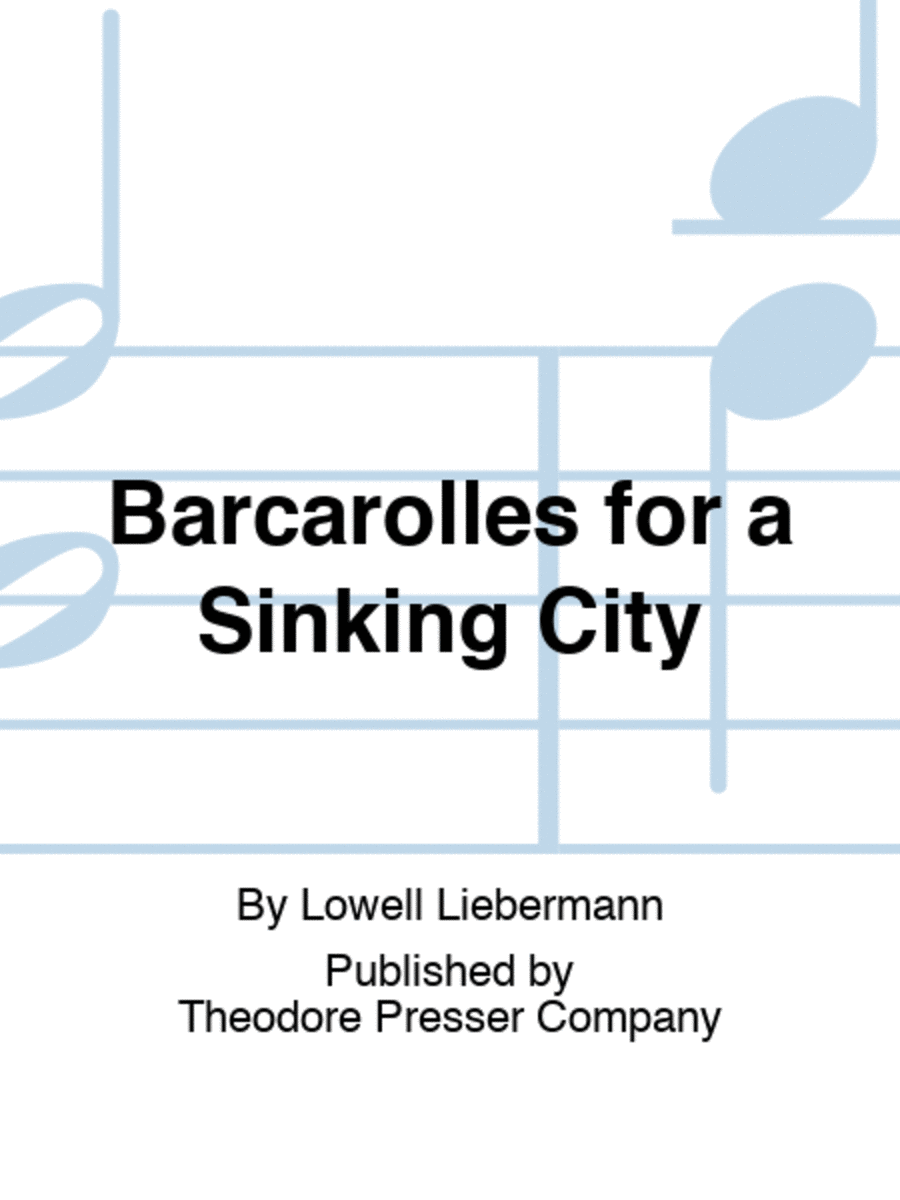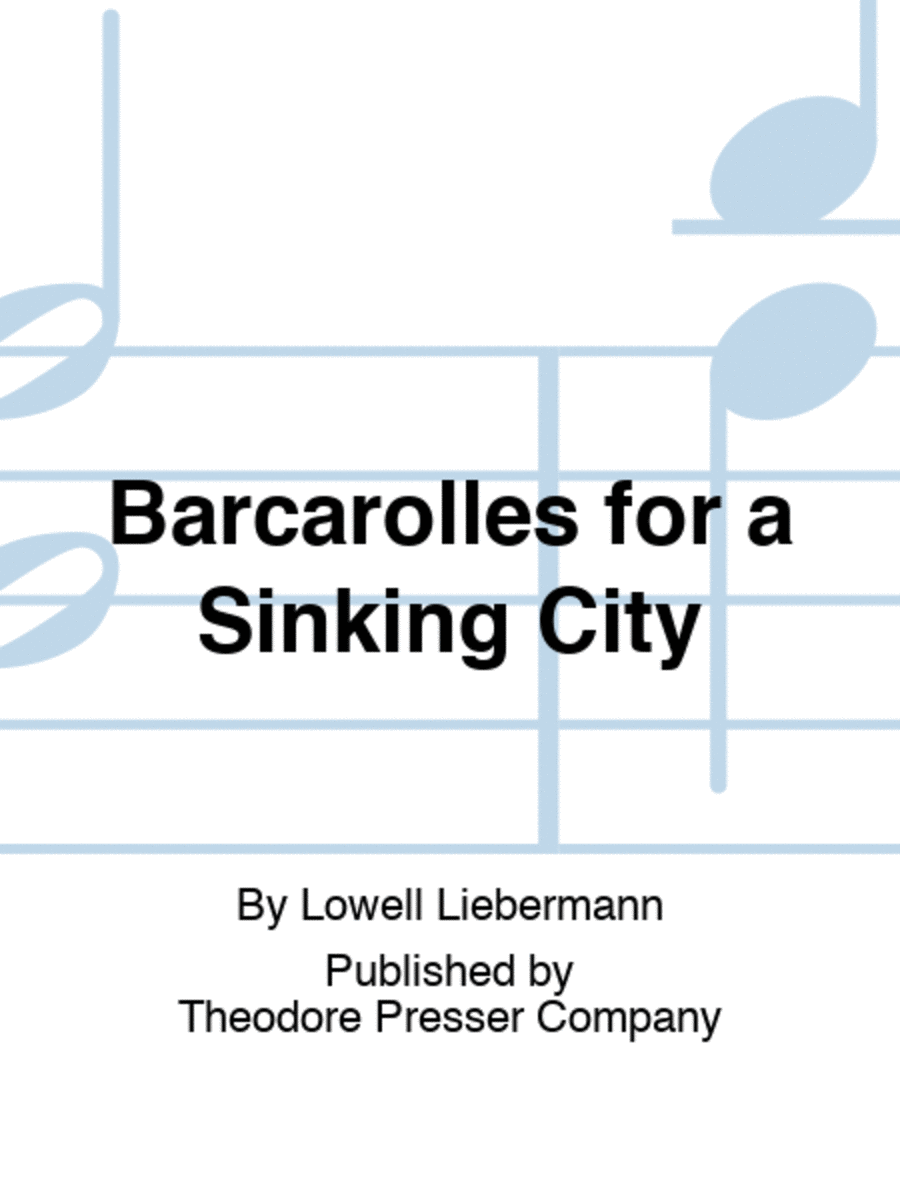Orchestra Bass Clarinet, Bassoon 1, Bassoon 2, Clarinet 1, Clarinet 2, Contrabass, Contrabassoon, English Horn, Flute 1, Flute 2, Harp, Horn 1, Horn 2, Horn 3, Horn 4, Oboe 1, Oboe 2, Percussion 1, Percussion 2, Percussion 3, Percussion 4, Piccolo and more.
SKU: PR.11641139S
Composed by Lowell Liebermann. Full score. Duration 15 minutes. Theodore Presser Company #116-41139S. Published by Theodore Presser Company (PR.11641139S).
UPC: 680160682119.
Barcarolles for a Sinking City was inspired by the city of Venice, a place that has long held the fascination of artists, writers and composers, and which I have been lucky enough to visit on several occasions. Sadly it seems that future generations may not be so lucky: in addition to the city's slow sinking and recently discovered tilting, studies predict that if global warming and the resultant rise of ocean levels is unabated, the entire city (as well as many other coastal cities around the globe) will be under water by 2100. I. Funeral Gondola The late, cryptic piano works of Franz Liszt made a profound impression on me as a young composer, among them two works he entitled La Lugubre Gondola (usually translated as The Funeral Gondola ) which were said to be a premonition of Wagner's death in Venice, his coffin transported through the canals in a black gondola. These late pieces of Liszt acquired even greater significance to me after I spent two summers in Bayreuth under the patronage of Friedelind Wagner, the granddaughter of Wagner and great-granddaughter of Liszt. This movement is a meditation on Wagner, Liszt, Venice and its own evanescence. II. Barcarolle/Quodlibet The Quodlibet (Latin for what pleases) is a musical form dating back to the 15th century where many disparate melodies are juxtaposed. Popular in the Renaissance, sacred and secular melodies were combined, often to comical effect due to the resultant incongruity of the words. The form was considered the ultimate test of a composer's mastery of counterpoint. The most famous Quodlibet is without doubt the final Variation of Bach's Goldberg Variations. As a form the Quodlibet is less common in more recent music, although examples can be found in the works of Kurt Weill and David Del Tredici. My own Barcarolle/Quodlibet was inspired by the (perhaps apocryphal) story of the funeral where musicians were asked to play a Bach Choral, but due to miscommunication played instead the Bacarolle from The Tales of Hoffmann. Here, the Bach Choral Allen Menschen mussen sterben (All Men Must Die) is heard in the strings pizzicato, with a tempo indication In slow motion. The alto line of the Bach suggests a phrase from Beethoven's Ninth Symphony (Alle Menchen werden Bruder) heard in the muted trombone. Before long, the famous tune from Offenbach's opera is heard, followed by quotations from iconic Barcarolles by Chopin, Mendelssohn and Faure, as well as two Venetian popular songs and more Beethoven. III. Barcarola/Ostinato/Carillon An ostinato is a repeated musical figure, and carillon is Italian for music box. This movement references the obsolete genre of salon pieces that imitated music boxes: such works by composers like Liadov and Gretchaninov used to be a mainstay of pianists' encore repertoire. This movement is however much darker in conception than those pleasant trifles. Utilizing the full battery of percussion, the carefully notated temporal slowing of the ostinato becomes overwhelmed by a poignant chorale melody before this box is snapped shut. IV. Barcarolle Oubliee (Forgotten Barcarolle) Marked limpido (still) the final movement begins with the sound of rain produced by a percussion instrument called (appropriately) a rain stick. Halting phrases in the harp coalesce into the accompaniment for a plangent melody heard in the clarinet. The central Adagio of this movement leads to a shattering climax, before the opening phrases return and dissipate into nothingness.
Publisher : Theodore Presser Co.$48.99 - See more - Buy online
 (AMERICAN COMPANY)
(AMERICAN COMPANY) 

